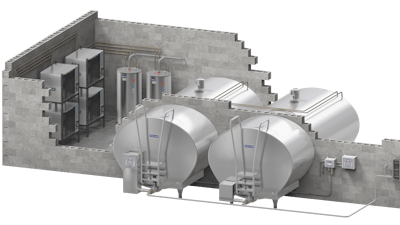How to Decide Between a Horizontal and Vertical Milk Tank
- Share on Facebook
- Share on LinkedIn
- Share on Email
-
Copy Link
-
Share Link
- Dairy Farm
- January 2, 2024
- 6 Minute Read
- Share on Facebook
- Share on LinkedIn
- Share on Email
-
Copy Link
-
Share Link

Introduction
When going through the process of purchasing a new milk-storage tank, one important consideration is whether to go with a horizontal or vertical tank. While the functionality and features of both options are the same, there are several factors that should drive your purchase decision. The following outlines the various benefits, differences, and considerations needed to help you make an informed decision.

Key Differences & Considerations
When choosing between a horizontal milk tank and a vertical milk tank—commonly known as a silo or Mueller Milk Tower™—placement is a defining factor. Horizontal tanks require an indoor environment, such as a dedicated tank room, while vertical silos are built for outdoor installation. However, outdoor silos come with specific requirements: a stainless steel cover must shield the agitator motor, and critical components like the manhole, outlet, inlet, ventilation, and sampling valve need to be housed within a tank room. As a result, both tank types rely on a tank room, though their configurations differ.
Another key distinction lies in milk sample collection. For horizontal tanks, drivers manually scoop samples from the stored milk. In contrast, vertical silos feature a sampling valve—developed after early outdoor designs faced contamination risks. This innovation led to a specialized protocol where an alcove connects the tank to the milking parlor, making the manhole, outlet, inlet, and sampling valve easily accessible.
Weighing the Benefits
Cost is often a deciding factor. Horizontal tanks typically have a lower initial price than comparable vertical silos. However, long-term expenses and site-specific constraints can shift the equation. Housing a horizontal tank demands a sufficiently sized indoor tank room, and construction costs may outweigh the price gap between the two options. If an existing tank room is available, the horizontal tank often proves more economical. For Paul Mueller Company tanks, the cost break-even point between horizontal and vertical designs occurs at the 28,000-liter capacity.
Space considerations also play a pivotal role. Vertical silos have gained popularity due to their compact footprint, offering greater flexibility in placement and optimizing farm space. This advantage shines in operations where major expansions aren’t feasible and land is at a premium. For example, a tank room for an 18,000-liter horizontal Mueller tank, built to recommended specs (5.95 x 3.63 m), occupies 21.6 square meters. Compare that to a vertical silo’s tank room for the same capacity, which requires just 17.75 square meters—saving 3.85 square meters of valuable space.
Quality You Can Trust
Whether you choose horizontal or vertical, effective cooling is non-negotiable for high-quality milk storage. At Paul Mueller Company, every tank is engineered for durability, reliability, and top-tier performance. As a global leader in dairy farming solutions, we’re committed to empowering professionals with the knowledge to select the ideal milk-cooling system for their unique needs. Need guidance? Contact our team to find the perfect solution for your farm.
More from Mueller Academy
- Introducing Our New Membrane-Based Water for Injection (WFI) Skids
- Manway Gasket Installation & Bushing Adjustment
- MES & PSG Feedwater Quality Requirements
- On-Site Tank Fabrication Under Deadline
- Finding the Right Finish: Understanding Polishing
- Increase the Capacity of Your Clean Utility Equipment
- Balancing a Mueller Multiple Effect Still (MES)
- The Different Types of Steam in Industrial Steam Generation
- How a Pure Steam Generator Works